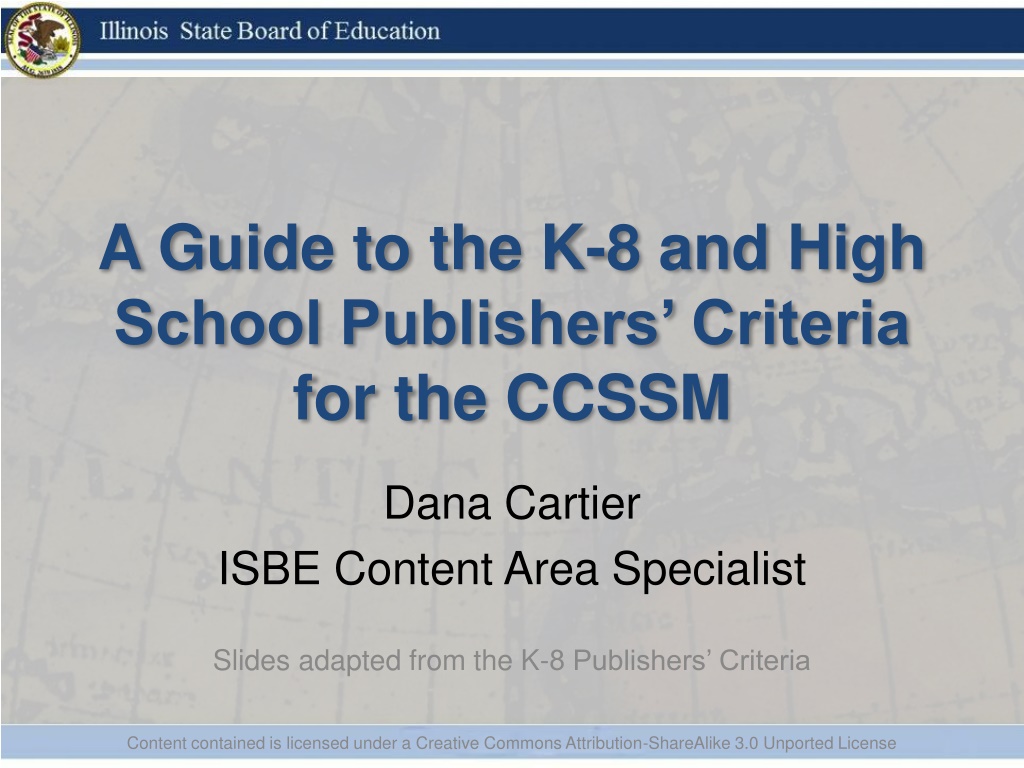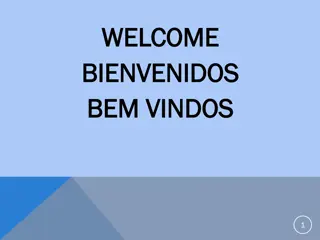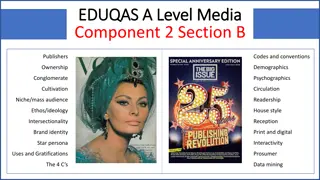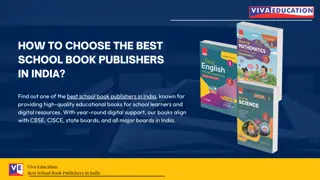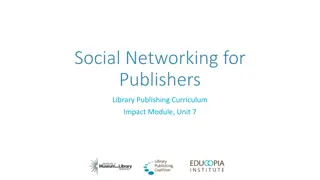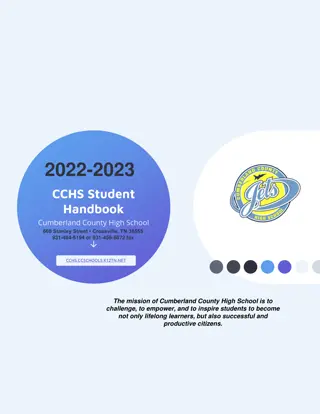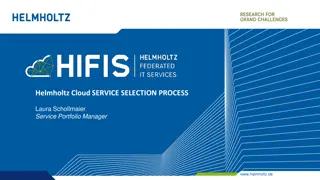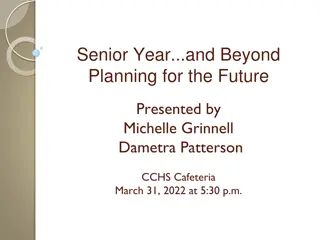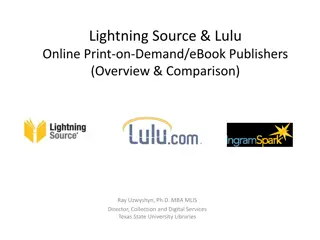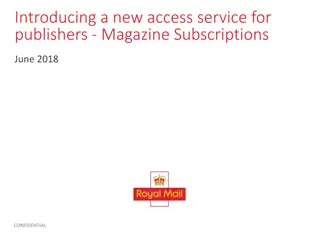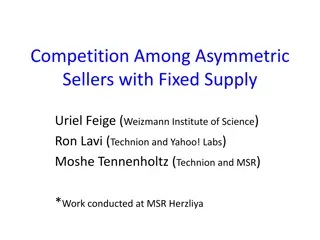Guide to K-8 & High School Publishers Criteria for CCSSM
This guide delves into the Publishers Criteria for CCSSM, emphasizing their importance in math education. Learn about the criteria, objectives, and why they are vital for student achievement. Explore tasks and comparisons to enhance understanding.
Download Presentation

Please find below an Image/Link to download the presentation.
The content on the website is provided AS IS for your information and personal use only. It may not be sold, licensed, or shared on other websites without obtaining consent from the author.If you encounter any issues during the download, it is possible that the publisher has removed the file from their server.
You are allowed to download the files provided on this website for personal or commercial use, subject to the condition that they are used lawfully. All files are the property of their respective owners.
The content on the website is provided AS IS for your information and personal use only. It may not be sold, licensed, or shared on other websites without obtaining consent from the author.
E N D
Presentation Transcript
A Guide to the K-8 and High School Publishers Criteria for the CCSSM Dana Cartier ISBE Content Area Specialist Slides adapted from the K-8 Publishers Criteria Content contained is licensed under a Creative Commons Attribution-ShareAlike 3.0 Unported License
3.OA.9 Task #1 Fill in the blank below and explain. 2, 4, 6, ____ Content contained is licensed under a Creative Commons Attribution-ShareAlike 3.0 Unported License
3.OA.9 Task #2 a) In each column and each row of the table even and odd numbers alternate. Explain why. b) Explain why the diagonal, from top left to bottom right, contains the even numbers 2,4,6,8, and 10. Content contained is licensed under a Creative Commons Attribution-ShareAlike 3.0 Unported License
Compare the Tasks What were the similarities and differences of the previous tasks? Content contained is licensed under a Creative Commons Attribution-ShareAlike 3.0 Unported License
Objectives Introduce the K-8 & High School Publishers Criteria Learn the why and how of using the criteria Explore the math criteria Content contained is licensed under a Creative Commons Attribution-ShareAlike 3.0 Unported License
What is the Publishers Criteria? Supports faithful implementation of the CCSSM Developed by the three lead authors Phil Daro, Bill McCallum, Jason Zimba Two different documents- similiar Content contained is licensed under a Creative Commons Attribution-ShareAlike 3.0 Unported License
Why Do We Need This? Standards cannot raise achievement. Material should connect to assessment. Educators complain about what is missing, but not about what has crept in. Content contained is licensed under a Creative Commons Attribution-ShareAlike 3.0 Unported License
Wiggins, 2012 Because conventional textbook coverage is so fractured, unfocused, superficial, and unprioritized, there is no guarantee that most students will come out knowing the essential concepts of algebra. Content contained is licensed under a Creative Commons Attribution-ShareAlike 3.0 Unported License
How Can We Use This Tool Inform purchase and adoption Work with previously purchased materials Review and guide teacher-developed materials Plan professional development Content contained is licensed under a Creative Commons Attribution-ShareAlike 3.0 Unported License
Part I: Major Shifts Focus Coherence Rigor Content contained is licensed under a Creative Commons Attribution-ShareAlike 3.0 Unported License
Focus Consider what is not said Math needs to lose a few pounds (p.3) Cannot add just one more thing Differentiation Extensions Grade-level work begins during the first two to four weeks of instruction Teach less, learn more Content contained is licensed under a Creative Commons Attribution-ShareAlike 3.0 Unported License
Math should make sense Coherence Practice-content coherence A progression of learning Coherence supports focus Use supporting material to teach major work Content contained is licensed under a Creative Commons Attribution-ShareAlike 3.0 Unported License
Rigor Balance with equal intensity Conceptual understanding Procedural skill and fluency Application Content contained is licensed under a Creative Commons Attribution-ShareAlike 3.0 Unported License
Conceptual Understanding Understand High-quality conceptual problems Elicit conversation Identify relationships Multiple representations
Fluency Fluently Methods are based on mathematical principles, not mnemonics or tricks Quickly and accurate, to work with flow. It isn t halting, stumbling, or reversing oneself.
Fluency Content contained is licensed under a Creative Commons Attribution-ShareAlike 3.0 Unported License
Fluency Example 2. Fill in the blanks below to make the equation true for every value of x. Explain the steps you took, as well as any math properties you used. ______ 2x+2 ( 1. Write a simplified expression for the following: 7r + 2(r + 3) )-4=10x+______ Content contained is licensed under a Creative Commons Attribution-ShareAlike 3.0 Unported License
Application Single-step and multi-step contextual problems Require students to make assumptions in order to model a situation Modeling a practice standard and a HS Conceptual Category Content contained is licensed under a Creative Commons Attribution-ShareAlike 3.0 Unported License
Application Problem my friend who is an event coordinator: My producer sent me only 50 feet of red velvet rope and 4 poles! I don t know what he was thinking, how can I fit all of the VIPs in this section? My phone beeps with a text from What is the mathematical question? Content contained is licensed under a Creative Commons Attribution-ShareAlike 3.0 Unported License
Application How many dinosaurs are standing in the lake? Explain how you know. Use words and mathematical language to explain your solution. Content contained is licensed under a Creative Commons Attribution-ShareAlike 3.0 Unported License
Part II: Criteria for Materials and Tools 10 criteria to analyze mathematics curricular materials 1 criterion to align mathematics to other disciplines Content contained is licensed under a Creative Commons Attribution- ShareAlike 3.0 Unported License
K-8 Publishers Criteria Part II: Criteria for Materials and Tools Aligned to the K-8 Standards Content contained is licensed under a Creative Commons Attribution- ShareAlike 3.0 Unported License
1. Focus on Major Work Better to inadvertently leave something out than to teach too much 65%-85%of time is spent on the major work Content contained is licensed under a Creative Commons Attribution- ShareAlike 3.0 Unported License
5th Grade PARCC Model Content Framework Content contained is licensed under a Creative Commons Attribution- ShareAlike 3.0 Unported License
2. Focus in Early Grades Don t cover material early Don t assess material early Patterns only within arithmetic Content contained is licensed under a Creative Commons Attribution- ShareAlike 3.0 Unported License
Content contained is licensed under a Creative Commons Attribution- ShareAlike 3.0 Unported License
3. Focus and Coherence through Supporting Work Supporting work enhances major work Supporting work does not detract from focus Content contained is licensed under a Creative Commons Attribution- ShareAlike 3.0 Unported License
2nd Grade Example from Measurement and Data Progression
4. Rigor and Balance Conceptual Understanding Fluency Application Three aspects are not always together. Three aspects are not always separate. Content contained is licensed under a Creative Commons Attribution- ShareAlike 3.0 Unported License
5. Consistent Progressions Grade-by-grade Grade-level problems Relating to prior knowledge Content contained is licensed under a Creative Commons Attribution- ShareAlike 3.0 Unported License
6. Coherent Connections Curricular material makes connections between clusters and domains CCSSM are more than a sum of their parts Content contained is licensed under a Creative Commons Attribution- ShareAlike 3.0 Unported License
7. Practice-Content Connections Not separate Present throughout Grounded in the content standards Accompanying teacher-support Content contained is licensed under a Creative Commons Attribution- ShareAlike 3.0 Unported License
8. Focus and Coherence via Practice Standards Connect practice and content standards as specified Structure for structural themes (MP7) Using repetition to find mathematical regularity (MP8) Content contained is licensed under a Creative Commons Attribution- ShareAlike 3.0 Unported License
9. Careful Attention to Each Practice Standard Full meaning and spirit of the entire practice standard Content contained is licensed under a Creative Commons Attribution- ShareAlike 3.0 Unported License
10. Emphasis on Mathematical Reasoning Construct viable arguments Problem-solving as argument Specialized language Content contained is licensed under a Creative Commons Attribution- ShareAlike 3.0 Unported License
Construct Viable Argument 25-50%of students time Independent thinking, classroom discussion and written work Critique arguments, error analysis Multi-step problems Student-devised strategy Cohesive arguments that can be verified and critiqued Not a jumble of steps
Specialized Language The language of argument, problem-solving and mathematical explanations are taught rather than assumed. Language of representations Diagrams, tables, graphs, symbolic expressions, drawing, images, text Helpful for ELL students Content contained is licensed under a Creative Commons Attribution- ShareAlike 3.0 Unported License
High School Publishers Criteria Part II: Criteria for Materials and Tools Aligned to the High School Standards Content contained is licensed under a Creative Commons Attribution- ShareAlike 3.0 Unported License
1. Focus on Widely Applicable Prerequisites Material should coherently include all of the standards in High School (without the + standards), with a majority of the time devoted to building the particular knowledge and skills that are most applicable and prerequisite to a wide range of college majors and postsecondary programs Content contained is licensed under a Creative Commons Attribution- ShareAlike 3.0 Unported License
Content contained is licensed under a Creative Commons Attribution-ShareAlike 3.0 Unported License
2. Rigor and Balance Conceptual Understanding Fluency Application Three aspects are not always together. Three aspects are not always separate. Content contained is licensed under a Creative Commons Attribution-ShareAlike 3.0 Unported License
3. Consistent Content Base course on content Give students extensive work with course-level problems Explicitly relates course content to prior knowledge Content contained is licensed under a Creative Commons Attribution-ShareAlike 3.0 Unported License
4. Coherent Connections Curricular material makes connections between clusters and domains CCSSM are more than a sum of their parts Content contained is licensed under a Creative Commons Attribution-ShareAlike 3.0 Unported License
5. Practice-Content Connections Not separate Present throughout Grounded in the content standards Accompanying teacher-support Content contained is licensed under a Creative Commons Attribution-ShareAlike 3.0 Unported License
6. Focus and Coherence via Practice Standards Connect practice and content standards as specified Structure for structural themes (MP7) Using repetition to find mathematical regularity (MP8) Content contained is licensed under a Creative Commons Attribution-ShareAlike 3.0 Unported License
7. Careful Attention to Each Practice Standard Full meaning and spirit of the entire practice standard Content contained is licensed under a Creative Commons Attribution-ShareAlike 3.0 Unported License
8. Emphasis on Mathematical Reasoning Construct viable arguments Problem-solving as argument Specialized language Content contained is licensed under a Creative Commons Attribution-ShareAlike 3.0 Unported License
Connecting Criterion: Consistency with CCSSM Materials for science and technical subjects are consistent with CCSSM Grade-level appropriate mathematics in other disciplines Content contained is licensed under a Creative Commons Attribution-ShareAlike 3.0 Unported License
Problems are worth doing Separate teacher material Support for diverse learners Indicators of Quality SHORT Variety in the pacing of each standard Best practices with manipulatives Variety of student products Visual design is clear Content contained is licensed under a Creative Commons Attribution-ShareAlike 3.0 Unported License
Avoid crosswalks Align to the letter and spirit of the standards Don t take the common out of COMMON core Content contained is licensed under a Creative Commons Attribution-ShareAlike 3.0 Unported License
